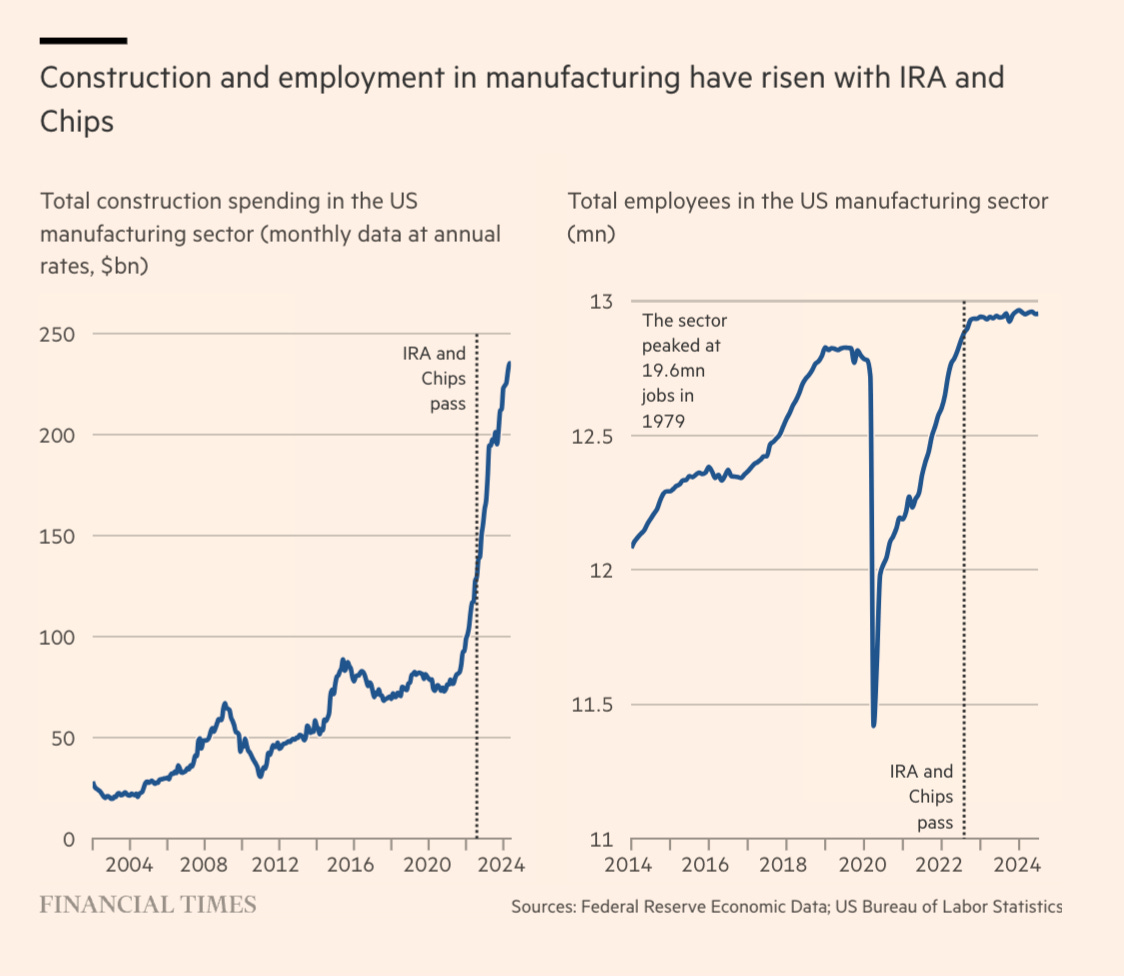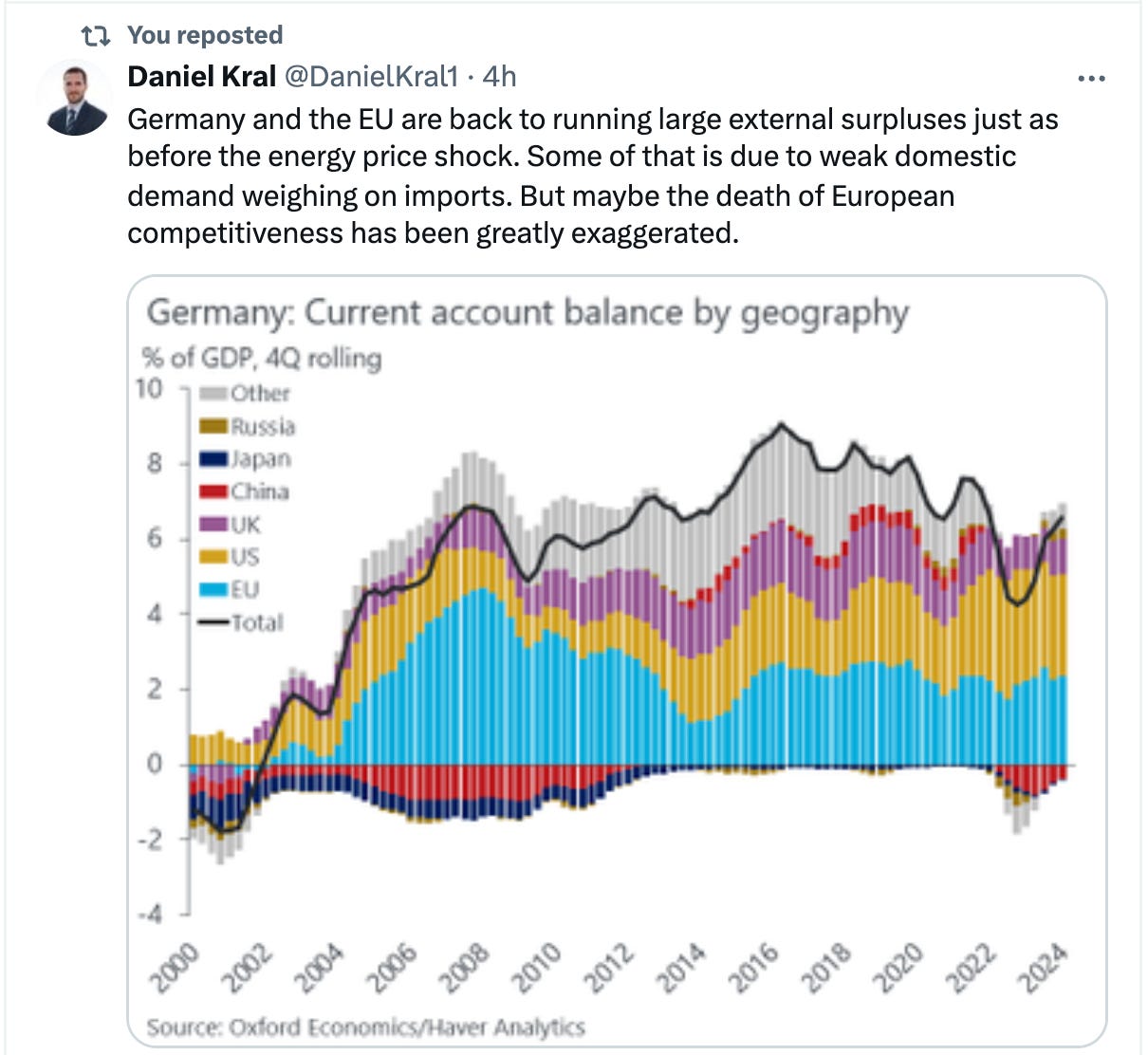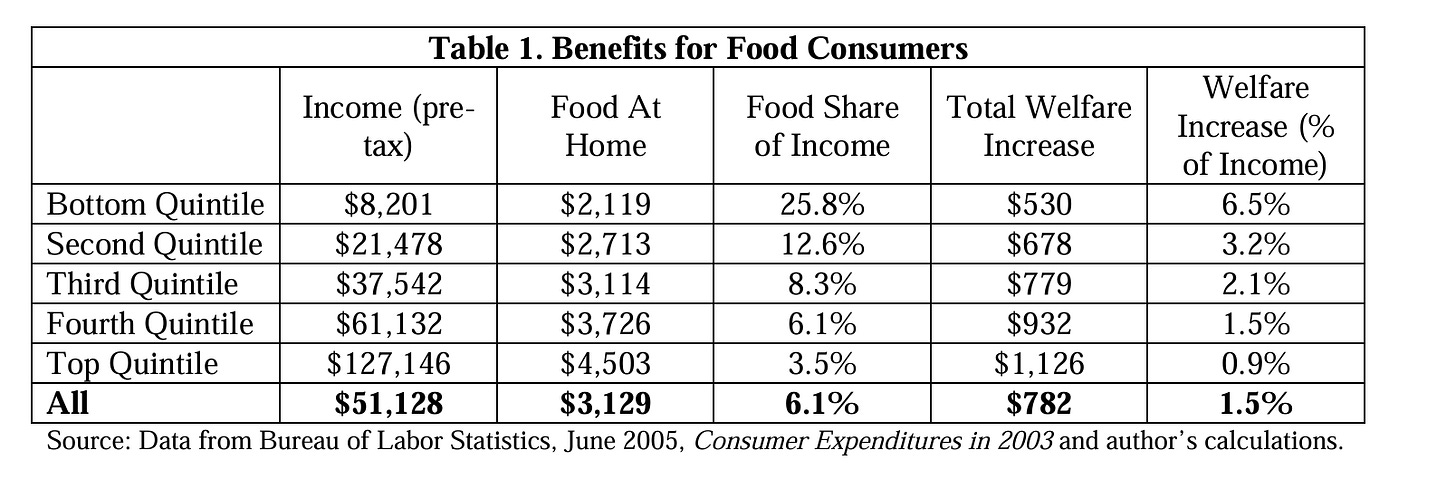Germany's gigantic trade surplus. Debating Walmart's grocery power. Max Headroom the first "AI" newscaster & the Sudan crisis.
Great links, images and reading from Chartbook newsletter by Adam Tooze.
Melanie Baker (1956-), Emperor (2017)
Team-Biden badly want a historic manufacturing boom to be his legacy. I just don’t get it. Here are the data with the timing of the Inflation Reduction Act (also CHIPS) inked in.
The surge in construction clearly began before the legislation, which is given credit for it. Employment has plateaued since the legislation was passed. This is not to criticize the legislation. The main criticism is simply that it should have been bigger and the Biden team would clearly have wished that too. It is simply to insist on realism to temper the triumphalist narrative and to be a bit careful about causal claims and the way we think about broader historical trends in the 2020s.
Data source: FT
Hi All!
Thank you for opening the Chartbook email. Your interest is much appreciated. Hope you enjoy the material collected here. It is the generous subscriptions of readers like you that keep this flow of content coming. A subscription costs $5 per month or $50 per year. To join the Chartbook supporters, click here:
Think about it! All this great content for the price of one cup of coffee per month.
Germany runs a trade surplus with the USA of more than 2 percent of German GDP!
And once you sign up, there are no more irritating “paywalls”.
This really cannot be said often or loudly enough: The energy transition at the global level has barely begun! It is a glimmer on the horizon not yet a trend-defining reality.
For subscribers only.
Walmart and America’s political economy - The following is an excerpt from Austin Frerick’s new book, “Barons: Money, Power, and the Corruption of America’s Food Industry,” now out at Island Press. Originally featured in Promarket
As bad as Walmart is for communities as a whole, it creates conditions that are particularly damaging for workers. As labor historian Nelson Lichtenstein noted, Sam Walton built a company rooted in a “southernized, deunionized post-New Deal America.” … Walmart employs about 1.6 million people in the United States alone, making it the nation’s largest private employer. In fact, more people are on the company’s payroll than the populations of eleven states. The company’s impact on the labor market is so big that it drives down wages in the areas in which it builds Supercenters. In the words of one academic, Walmart effectively “determine[s] the real minimum wage” in the country. That’s why it’s national news when the company decides to raise wages.
From its founding, Walmart has been notorious for its poverty-level wages; in its early years, the company exploited a loophole in order to pay the mostly female store employees half of the federal minimum wage. It took a federal court battle for the workers to receive the minimum wage. In 2021, Walmart employees’ median income was about $25,000, whereas CEO Doug McMillon took home $25.7 million that year. …. Over the years, the company has aggressively fought efforts to unionize, and it seemingly closes stores whenever they gain traction. … And it’s not just labor laws that the company has eluded. A 2017 report based on a survey of over one thousand Walmart employees found that the company was likely violating worker protections such as the Americans with Disabilities Act and the Family and Medical Leave Act, among others. … As the company’s power grew, it reshaped labor options and norms for millions of Americans. Gary Chaison, a labor expert, told the New York Timesin 2015, “What you’re increasingly finding is that it’s the primary wage earners who work at Walmart, because a lot of workers have more or less given up on getting middle-class jobs.” … This power imbalance between Walmart and its employees explains the poverty-level wages for many of Walmart’s 1.6 million workers but also for employees of its competitors. Some unionized grocery stores have even used the opening of a Walmart Supercenter as an excuse to demand cuts to their own employees’ wages and benefits.
These low wages also obscure a generous hidden subsidy that the company receives from taxpayers. Many Walmart workers depend on government public assistance programs such as Medicaid (health care), the Earned Income Tax Credit (a low-wage tax subsidy), Section 8 vouchers (housing assistance), LIHEAP (energy assistance), and SNAP (food assistance), among others. In 2013, one estimate by congressional House Democrats found that taxpayers subsidized Walmart to the tune of more than $5,000 per employee each year through all of the government assistance programs that its workers need.
In effect, instead of paying a living wage to these employees, the Walton family shifts the burden onto taxpayers. Although many people may recoil at the idea of the public filling the gap between Walmart’s pay and the income its workers need to survive, not all policymakers see an issue with this sort of billionaire welfare. Jason Furman, former chair of the Council of Economic Advisers under President Obama, wrote a paper before joining the administration titled “Wal-Mart: A Progressive Success Story” that called for even more of these subsidies to Walmart’s bottom line.
Furman’s 2005 study is well-worth checking out. The main punchline is that the lower cost of food produced by big box grocery competition then benefited consumers to a considerable degree.
Back to Frerick:
In some instances, Walmart even receives a double subsidy. Its workers and shoppers frequently rely on SNAP, formerly known as “food stamps.” The program originated as part of the New Deal as a temporary measure and was made permanent by President Lyndon Johnson in a bill signed in 1964. This program and several smaller food assistance programs are now part of the Farm Bill. In fact, these food assistance programs make up more than 75 percent of the most recent Farm Bill. SNAP is in many ways a triumph of progressive social policy, with an average of 41.2 million people participating in the program each month in 2022. The use rate is so high because, unlike many other programs, SNAP was structured by the US Congress so that anyone who qualifies is guaranteed to receive assistance. As a result, the program is a lifeline for millions of Americans who might otherwise struggle to put food on the table.
But because of Walmart’s dominance of the grocery sector, a very large portion of SNAP dollars now run through the company’s cash registers. In 2013, the company received $13 billion in sales from shoppers using SNAP. By comparison, farmers markets took in only $17.4 million of all SNAP spending that same year. The amount of SNAP money received by the company surged with the expansion of SNAP benefits in response to the COVID-19 pandemic. With some back-of-the-envelope math, I came up with a rough estimate that Walmart now receives somewhere around $26.8 billion each year from SNAP.
Unfortunately, more concrete numbers are not available because the US Supreme Court has ruled that the amount of taxpayer money that the company receives from SNAP can be kept secret. In 2019, the Court heard a case involving the USDA’s decision to deny a request by a South Dakota newspaper for this information. “Most of the time, the government tells the public which companies benefit from federal dollars earmarked for taxpayer-funded public assistance programs,” agriculture and food reporter Claire Brown noted. “We know which insurance companies make the highest profits from Medicare and Medicaid, for example, and those figures have been used to pressure them to offer better options to their clients.” But in this instance, the Court rejected this level of transparency, with Justice Elena Kagan joining the Republican-appointed members of the Court to uphold the USDA decision under the notion that it was “confidential” business information.
The program is important enough that it factors into Walmart’s operational decision-making. Many Americans enrolled in SNAP schedule their trips to the grocery store around the days when their funds get deposited. In fact, the company factors this bump into its ordering system.
Melanie Baker, Aquileia Lion
To say the Sudan conflict has been forgotten is too kind: the world is largely indifferent – apart from those who hope to profit there
It’s hard to get aid to Sudanese civilians, but weapons flow towards them endlessly through each of the country’s neighbours. The destruction they wreak forces people to flee: 10,000 children are displaced each day. The suffering now will be matched by future pain. Girls as young as eight are being raped by fighters, Unicef has reported, and babies born of sexual violence are being abandoned. Famine is intensifying and 25 million people are experiencing acute hunger, as the belligerents block aid deliveries …. The International Organization for Migration warns that the situation is at breaking point, with the prospect of tens of thousands of preventable deaths unless there is an immediate and massive global response. Heavy rains and flooding have exacerbated the humanitarian crisis, but its real cause is the conflict that began more than a year ago, when the Sudanese Armed Forces (SAF) under Gen Abdel Fattah al-Burhan and the Rapid Support Forces (RSF) under Mohamed Hamdan Dagalo, known as Hemedti, turned upon each other. The Sudanese military didn’t turn up for talks in Geneva on Wednesday that were supposed to pursue a ceasefire deal. The RSF – which the army birthed and worked with to eject the civilian government – did. But its leaders can hardly pose as the peacemakers while continuing their campaign of terror. … . Jockeying by outside powers, despite their denials of involvement, has fuelled the conflict. UN sanctions monitors have noted “credible” allegations that the UAE is supplying the RSF. Egypt and Saudi Arabia, which is cohosting these talks, are aligned with the SAF. All are present at these talks. Russia appears to have tried to play both sides, though it may be shifting towards the army. Arms made in China, Turkey, Iran and Serbia have been spotted. … James Elder, the Unicef spokesperson, described Sudan as “a crisis of neglect”. That is almost too kind a description. … the UN relief effort is only one-third funded. The telescoping of Sudanese aspirations, from the grand horizon of the 2019 revolution and civilian leadership to the daily struggle for survival, has been sudden and brutal.
Great editorial this by the Guardian.
Max Headroom is a fictional character played by actor Matt Frewer. Advertised as "the first computer-generated TV presenter",[1] Max was known for his biting commentary on a variety of topical issues, arrogant wit, stuttering, and pitch-shifting voice. The character was created by George Stone,[2] Annabel Jankel, and Rocky Morton. Max was advertised as "computer-generated", and some believed this, but he was actually actor Frewer wearing prosthetic makeup, contact lenses, and a plastic moulded suit, and sitting in front of a blue screen. Harsh lighting and other editing and recording effects heighten the illusion of a CGI character.[3] According to his creators, Max's personality was meant to be a satirical exaggeration of the worst tendencies of television hosts in the 1980s who wanted to appeal to youth culture, yet were not a part of it. Frewer proposed that Max reflected an innocence, largely influenced not by mentors and life experience but by information absorbed from television.[3] Max Headroom debuted in April 1985 on Channel 4 in the British-made cyberpunk TV movie Max Headroom: 20 Minutes into the Future, his origin story. In the movie, Edison Carter (portrayed by Frewer) is a journalist fleeing enemies into a parking garage, crashing his motorcycle through the entrance barrier reading "Max. headroom 2.3 metres" - UK vehicle clearance signs use the phrase "Max headroom". While Carter is unconscious, an AI program based on his mind is created. The AI develops a personality identified as "Max Headroom", and becomes a TV host who exists only on broadcast signals and computer systems. Like Carter, Max openly challenges the corporations that run his world, but using commentary and sarcastic wit rather than journalism.[4]
Source: Wikipedia
Melanie Baker, Dionysus 2015
If you have scrolled this far, you know you want to click.











